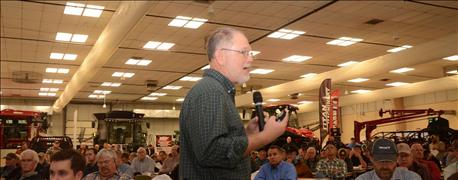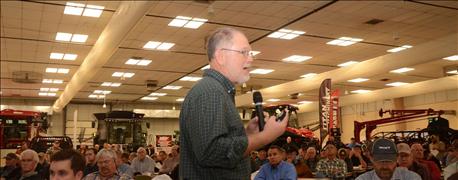
It's a question on everyone's mind this year: how do we manage in these times of tight margins? Bob Nielsen, Purdue University professor of agronomy and Extension corn specialist addressed the topic to over 400 farmers at the Fremont Corn Expo in early January.
In addition to grain price, the two driving factors of contribution margins are yield and variable cost of production. So, one way to improve contribution margin is to increase yield relative to variable cost per bushel, and ensuring yields are consistent from year-to-year. Another way is to decrease the variable cost of production, as long as it doesn't reduce yield.
"That's where the agronomic challenge is. Once you shave it far enough, there just isn't much more to shave without cutting yield," Nielsen says. "It's the variable cost of production you need to be looking at as you increase yield to improve your contribution margin, and that's where it gets a little dicey."

KNOW YOUR COSTS: The challenge is to increase yield for not much more than variable cost per bushel, or decrease variable costs without sacrificing yield. That's why Nielsen says it's important to put your own budget together and know your variable cost per bushel.
How can growers strike a balance between variable input costs and yield? It depends on the individual operation and the operation's cash flow. It's important to monitor things closely, know the operation's challenges, the exact cost per bushel of production, and pay attention to the crop all season long.
Growing good corn consistently doesn't mean throwing everything and the kitchen sink at the crop – it has to be economical. It starts with identifying and managing yield-limiting factors specific to the farming operation. "If you can do a good job of identifying the yield-limiting factors that are important for your operation, you will increase yields, you will grow corn more consistently," Nielsen says. "If you fail to do that and you're just throwing the kitchen sink, or just this input or that input, if you're doing it willy-nilly without knowing if it's a solution for a problem you actually have, you're just throwing darts."
This takes a boots on the ground approach, recognizing the problems, identifying where they are in the field, taking time to correctly diagnose the causes, and alleviating those problems and hopefully increase yield or reduce variable costs. Precision agriculture technology, remote sensing, and Big Data are great supplements to this kind of agronomy, but do not replace agronomy, Nielsen says.
So, what variable costs should be looked at? Seed, fertilizer, and pesticide are the most significant. "If there's an opportunity to do a better job of selecting hybrids and get 20 to 40 free bushels, think what that does to your contribution margin," Nielsen says. Identifying hybrids that perform well year-to-year isn't easy, however, especially with recent periods of extreme variability in weather. That's why it helps to have a wide range of trial data to identify varieties that work well in different conditions and locations.
When it comes to quantitative inputs like nitrogen and seeding rate, it can be challenging to determine the right rate. On-farm research is a key tool to use here, especially on the aggregate level. With enough data gathered in different conditions, growers can create a yield response curve to get a good idea of what the optimum economic rate is. Nielsen notes in a typical yield response curve, as nitrogen or seeding rate increases beyond a certain point, the yield response is less, and eventually plateaus.
"The economic rate is always less than the rate that technically maximizes yield because you cannot afford to get the last few bushels out of that nitrogen fertilizer, you cannot afford to get the last few bushels out of population," he says. "Without this kind of response curve, you're throwing darts to determine what the agronomic optimum is or what the economic optimum is."
Then there are variable inputs Nielsen refers to as "crop insurance inputs." That is, inputs like micronutrients, foliar insecticides, and in some cases where they may not be needed, foliar fungicides. "It might be products that are too good to be true. These are things we apply because they sound good and they're only $3, $4, $5 an acre," he says. "I really don't want to leave any yield on the table, but we really don't know if they're going to increase yield."
Certain things are common sense – foliar fungicides are effective when they are needed, when growing a susceptible variety and samples indicate diseases are present. Similarly, it's important to know what weeds, especially resistant weeds, pose a threat in the area, and to control them up front and prevent them from getting a chance to spread and get too big to control.
That's why it's important to know the problems specific to the farming operation, and to pay close attention to the crop throughout the growing season. "Recognize there's no such thing as a one-size-fits-all solution that works for everybody," Nielsen says. "As we struggle to improve this contribution margin over the next couple of years, understand that we can try to decrease those variable costs if there's anything less to shave, or you can try to increase yield cost-effectively for not much more than your variable cost of production per bushel."
About the Author(s)
You May Also Like






